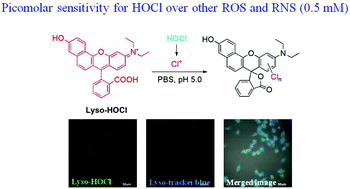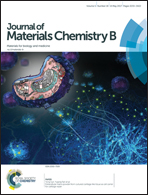A highly specific and ultrasensitive fluorescent probe for basal lysosomal HOCl detection based on chlorination induced by chlorinium ions (Cl+)†
Abstract
The development of techniques for detecting HOCl at the subcellular level is very important to elucidate its cellular functions. Due to its relatively low concentration, it is still a great challenge to specifically track the basal HOCl in normal cells. In this paper, based on the unique chlorination of HOCl by the initiation of chlorinium ions (Cl+) in an acidic medium, we have developed a simple pH-mediated lysosome-targetable fluorescent probe Lyso-HOCl for the specific detection of HOCl over other bioactive molecules at higher concentration (500 μM). Our results show that Lyso-HOCl possesses a detection limit of 8.0 pM, and can quantitatively detect HOCl at the picomolar level. The ultrasensitive and ultrafast response property of probe Lyso-HOCl offers a good opportunity to monitor the basal HOCl and the fluctuation of endogenous HOCl levels in the lysosomes of macrophages (Raw 264.7 cells), and we thus anticipate that this probe would provide a promising tool for further unraveling the biological functions of HOCl in subcellular lysosomes.

- This article is part of the themed collection: JMC B Editor’s choice web collection: ‘‘seeing the unseen updated: advances in biosensing’’


 Please wait while we load your content...
Please wait while we load your content...